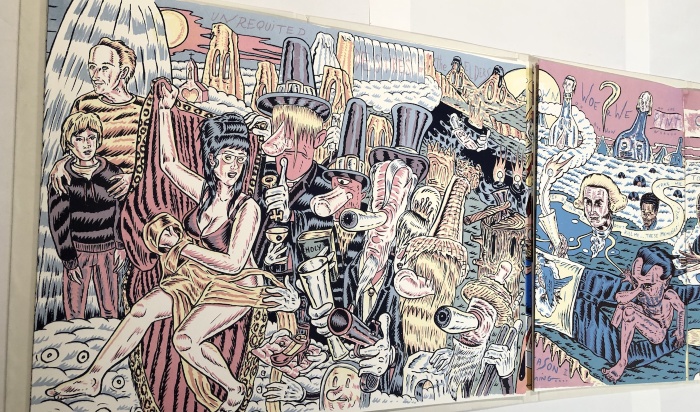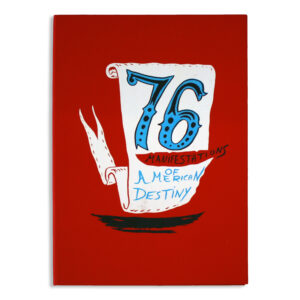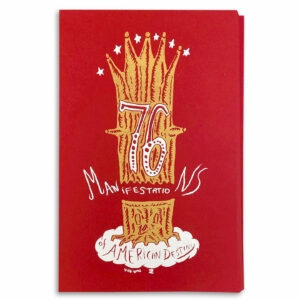76 Manifestations of American Destiny, Volume III: Mythic Heroes, Mythic Villians
76 Manifestations of American Destiny, Volume III: Mythic Heroes, Mythic Villians
Date
2017
Edition Size
20
Media
Silkscreen
Format
Artist Book
Dimensions
22.75 × 30.5 in
Collection
Collection Development, Limited Edition Artists Books$ 7,000.00
1 in stock
View Collectors
Bainbridge Island Museum of Art
Claremont Colleges Library
Getty Research Institute
New York University (NYU)
School of the Museum of Fine Arts (SMFA) at Tufts
“For the past two years, I’ve been creating sketches for a set of prints depicting the American pantheon— both historical characters and events, and those in the realm of legend. I believe the United States is on the cusp of great change, transitioning to a post-empire psyche, at the very least, and that its historical/mythological landscape will change with it. My new series of prints will represent American heroes and villains of fact and fiction and iconic occurrences and folktales in this fresh context. During the past year, I have begun work on the first volume, which consists of 13 prints and folds out to be almost 30 feet in length. I have also been working on an accompanying series of paintings.
Much of my work over the past 30 years has been concerned with examining American culture and politics. This series will allow me to explore the aspects of American history and legend that still haunt the present, including moribund concepts periodically revivified by nativists, Tea Partiers, and the like, such as manifest destiny and American exceptionalism.
This project was inspired by the woodblock prints of the great 19th-century Japanese artist Taiso Yoshitoshi, whose work I was recently able to study closely as a Cullman Fellow at the New York Public Library. I am loosely basing my series on his masterwork One Hundred Aspects of the Moon, an elegiac hearkening back to iconic events and characters in history and culture in response to momentous political and social changes in Meiji-era Japan. While his subjects were famed Samurai warriors, tragic lovers, and notorious villains, I reference U.S. presidents and other political leaders, Civil War battles, and tabloid sex scandals. In parallel with Yoshitoshi’s allusions to classic poems, I depict images drawn from American country songs like Long Black Veil and In the Pines.
Unlike Yoshitoshi’s, however, my work is less romantic than iconoclastic, and I also draw from Goya, Gilray, Dix, and other printmakers of satiric commentary. As in my previous books series, I use elements of contemporary narrative and those of earlier eras; in this series, ukiyo-e is joined by 20th-century comics and 19th-century Visionary art— Jack Kirby meets William Blake. The scope will be mock epic, a style I often use to lighten the content of my subjects. For example, I use my family and myself to stand in as reenactors of classic scenes of America’s revered lore. I also inject references to contemporary analogs—keeping an eye out for how these icons from the past reappear in modern guise.
Each image will be printed (silkscreen and/or lithograph) to stand alone but will also be linkable with 10 to 12 others to form an accordion book; the 7 to 10 accordion books will, in turn, become part of a unified volume called 76 Manifestations of American Destiny.
The expansiveness of the books’ form also represents the expansiveness of the American landscape; it might be thought of as a road trip through the swamplands, cumulus skies, and exurban vistas of American history. The covers for the combined volume will be the east and west coasts of the continent, to echo the notion of manifest destiny.
As a maker of visual art in book form, I have a special interest in how the physical manifestation of the work itself influences the structure of the narrative and vice versa. In this case, the images unfold in a continuum: Some morph to represent contemporary political exploitation of archetypal American iconography; others fade away—but never entirely—reappearing like restless ghosts.
My interest in printmaking drew me to pre-modernist artists who used narrative devices such as symbolism and allegory to amplify their social commentary (Goya’s Los Caprichos, Hogarth’s Marriage à la Mode). Eccentric modernist painters like Beckmann, Ensor, and Guston inspired explorations into the mythic/transformative utility of personal history.
I believe the (artist’s) book rather than the single image is the ideal medium for me to explore content and experiment with form and narrative possibilities. In addition to this current project, over the past 30 years, I’ve created two other major series of artist’s books: Burning Ring of Fire and A Sinner’s Progress (which was recently purchased by the Library of Congress). In the first series, I used the road-trip trope and played off Dante’s Divine Comedy, which allowed me to devise a complete world for my protagonist. In A Sinner’s Progress, I set up a modern moral journey, loosely based on John Bunyan’s A Pilgrims Progress. The books in these series have taken many different structures, ranging from complex hand-bound silkscreened editions to offset pulp-style comics—each volume’s form in service to its function to some extent.”
— David Sandlin
Accompanying Volumes: I: In the Beginning, II: From the Golden Age to the Gelded Age, IV: Tree of Liberty.














